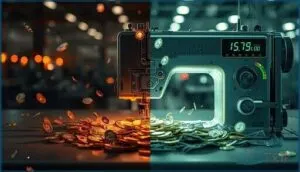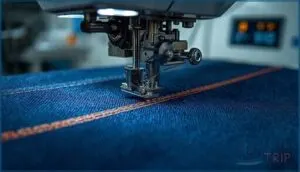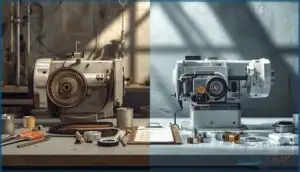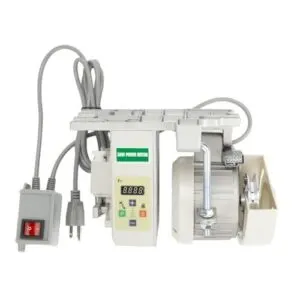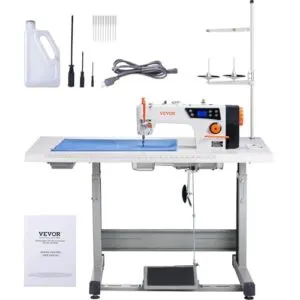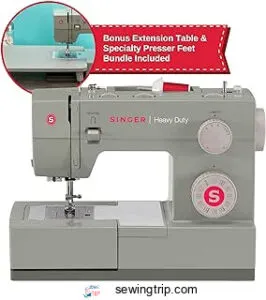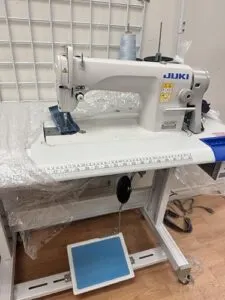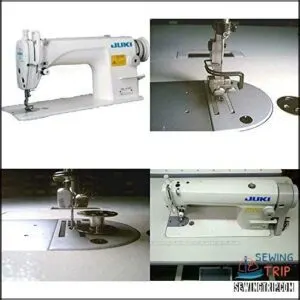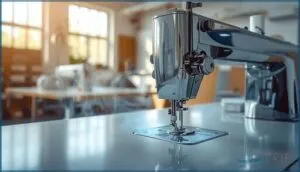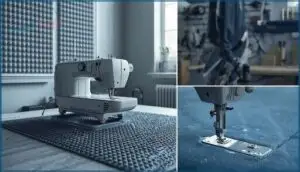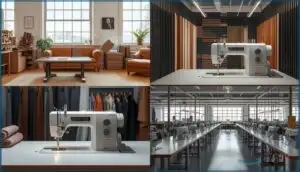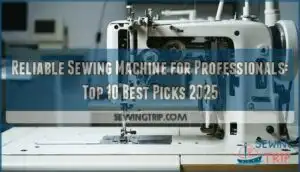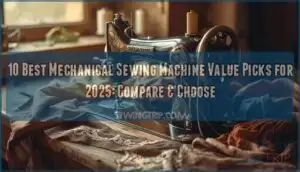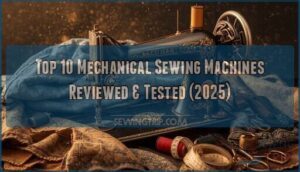This site is supported by our readers. We may earn a commission, at no cost to you, if you purchase through links.

Professional sewing operations face a persistent challenge: traditional clutch motors generate 85-90 dB of noise, roughly equivalent to standing next to a busy highway. That level of sound exposure creates compliance headaches with OSHA regulations, increases worker fatigue, and limits where you can set up shop.
The solution isn’t soundproofing your entire workspace—it’s choosing industrial sewing machine quiet operation technology from the start. Servo motors with brushless designs now deliver the same power and precision at 60-70 dB, cutting noise by up to 30 decibels while reducing energy consumption by 70%.
You’ll find eight machines and motor systems that combine professional-grade performance with sound levels low enough for residential neighborhoods, plus the technical specifications that determine whether a machine will actually operate quietly in your environment.
Table Of Contents
- Key Takeaways
- Key Features of Quiet Industrial Sewing Machines
- Comparing Servo Motors Vs. Clutch Motors
- Top 8 Quiet Industrial Sewing Machines & Motors
- 1. Servo Motor Sewing Machine Silent Brushless
- 2. Industrial Sewing Machine Servo Motor
- 3. Ceelpeopar Sewing Machine Servo Motor
- 4. VEVOR Industrial Lockstitch Sewing Machine
- 5. Singer Heavy Duty Sewing Machine
- 6. Juki DDL-8700 Industrial Sewing Machine
- 7. Juki Lockstitch Industrial Sewing Machine Combo
- 8. Juki Heavy Duty Sewing Machine
- Factors for Selecting a Quiet Sewing Machine
- Tips to Reduce Sewing Machine Noise
- Quiet Operation for Different Industrial Applications
- Frequently Asked Questions (FAQs)
- Conclusion
Key Takeaways
- Servo motors with brushless designs cut industrial sewing machine noise from 85-90 dB down to 60-70 dB while reducing energy consumption by up to 70%, making them significantly quieter and more cost-effective than traditional clutch motors.
- The noise reduction comes from eliminating friction-based components like belts and brushes, combined with vibration dampening through metal frames and isolation mounts that can further reduce sound levels by 3-4 dB.
- Upgrading to servo motor technology typically pays for itself within 2-4 years through electricity savings of $700+ annually per machine, while also extending equipment lifespan by 30-40% due to reduced mechanical wear.
- Quiet operation isn’t just about comfort—it directly impacts OSHA compliance, expands location flexibility for home-based or apartment operations, and protects worker hearing health in industrial settings.
Key Features of Quiet Industrial Sewing Machines
Modern industrial sewing machines tackle noise in ways that go far beyond just turning down the volume. The difference comes down to how motors, frames, and control systems work together to cut vibration and sound at the source.
Here’s what separates a truly quiet machine from one that just claims to be.
Servo Motor Technology for Noise Reduction
Since servo motors eliminate belts and gears with their Direct Drive design, you’ll experience significant noise reduction from the start. The servo motor technology gives you precise Speed Control while cutting energy waste by up to 70%, naturally lowering operational noise to 60-70 dB.
This Design Influence on quiet operation also delivers vibration reduction and Maintenance Benefits, as fewer moving parts mean less friction and mechanical stress during weaving tasks.
These motors are also energy efficient models, consuming power only when the machine is in use.
Brushless and Microprocessor-controlled Motors
Brushless motor technology eliminates brush friction completely, pushing energy savings to 80% while cutting noise below 60 decibels. You’ll benefit from Electronic Commutation that provides smooth Torque Delivery and reduces mechanical wear. These microprocessor-controlled motors adjust power based on workload, making Predictive Maintenance through IoT Integration. Friction generates noise in brushed motors. That Motor Efficiency means consistent quiet operation across varying speeds, with real-time monitoring ensuring best servo motor performance throughout production.
- Brushless design removes friction-based noise sources
- Microprocessor control makes precise speed regulation
- Electronic systems reduce electromagnetic interference
- Smart sensors support predictive maintenance capabilities
- Energy efficiency reaches 60-80% improvement rates
Vibration Dampening and Frame Materials
Beyond motor technology, machine frame materials and vibration dampening determine your sewing environment’s actual noise level. Metal frames with aluminum or steel construction suppress vibrations more effectively than plastic alternatives, reducing frame flex during operation.
Silicone isolation mounts beneath your machine cut noise by 3-4 dB while preventing movement. Elastic dampening devices between the frame and table platform reduce vibration speed by 10-12 times, extending machine life up to 200% through reduced mechanical wear.
Energy Efficiency and Quiet Operation Benefits
Quiet operation pairs directly with energy savings in servo motor systems. You’ll see up to 70% lower electricity consumption compared to clutch motors, translating to 50-70% annual cost savings while reducing emissions proportionally.
Lower operational temperatures improve workplace comfort, and reduced vibration extends machine longevity by 30-40%.
These productivity gains and motor efficiency improvements position noise reduction as an economic advantage, not just an acoustic one.
Comparing Servo Motors Vs. Clutch Motors
When you’re choosing between servo and clutch motors for your industrial sewing setup, the differences go beyond just noise levels. Energy costs, stitch consistency, and maintenance time all shift depending on which motor drives your machine.
Let’s break down the key factors so you can make the right call for your operation.
Noise Level Differences
When you’re weighing motor types, the decibel levels tell the real story. Clutch motors idle above 85 dB and surge higher during operation, while servo motors stay silent when not sewing and drop noise levels by 10–20 dB when active. This reduction brings most machines well under OSHA standards, cutting vibration and targeting frequency impact above 1 kHz for genuinely quiet operation.
| Motor Type | Idle Noise | Operating Noise |
|---|---|---|
| Clutch Motor | 85+ dB | 90+ dB |
| Servo Motor | Nearly Silent | 70–80 dB |
| Reduction Trends | — | 10–20 dB Lower |
Energy Consumption and Cost Savings
Savings stack up fast when you factor in wattage, runtime, and idle behavior. Servo motors draw power only during active stitching, slashing energy consumption by 50–70% compared to clutch motors that run continuously. Factories see annual electricity savings of up to $700 per machine, with payback periods of 2.3–3.7 years. Green incentives and reduced fabric impact from precise speed control boost efficiency even further.
Servo motors cut energy use by 50–70% and pay for themselves in under four years through electricity savings alone
| Feature | Clutch Motor | Servo Motor |
|---|---|---|
| Motor Wattage | 500W continuous | 550W on-demand |
| Energy Reduction | Baseline | 50–70% lower |
| Cost Payback | — | 2.3–3.7 years |
| Green Incentives | Limited eligibility | Qualifies for rebates |
Performance and Stitch Quality
Precision matters when you’re pushing thousands of stitches per minute. Servo motors deliver stitch uniformity above 98%, while tension control keeps seam failure rates under 2%—far better than the 8% you’ll see with inconsistent manual setups. Speed impact is real: machines hit 8,000 SPM without sacrificing fabric handling, even through 12 layers of heavy material, and defect monitoring systems catch 95% of flaws before they leave the line.
| Feature | Clutch Motor | Servo Motor |
|---|---|---|
| Stitch Uniformity | 92–95% | 98%+ |
| Seam Failure Rate | 5–8% | Under 2% |
| Max Speed (SPM) | 3,500–5,000 | 8,000+ |
Maintenance Requirements
Bearing failures account for 51% of motor breakdowns, but you can prevent most through proper lubrication frequency and component inspection. Servo motors demand far less attention than clutch systems—no belts to adjust, fewer parts wearing down, and reduced vibration means bolts stay tight longer. Motor servicing drops to annual intervals, while needle replacement and routine checks keep your machine running clean.
| Maintenance Task | Clutch Motor | Servo Motor |
|---|---|---|
| Lubrication Frequency | Every 8-10 hours | Monthly oil check |
| Belt Replacement | Quarterly | Not required (direct-drive) |
| Annual Servicing | Extensive repairs | Inspection only |
| Vibration Analysis | Weekly recommended | Quarterly sufficient |
Top 8 Quiet Industrial Sewing Machines & Motors
You’ve seen how servo motors cut noise and save energy, but choosing the right machine still matters.
The models below combine quiet operation with the power and precision you need for industrial work.
Each option brings something different to the table, whether you’re running a production floor or setting up a home studio.
1. Servo Motor Sewing Machine Silent Brushless
You’ll notice this servo motor eliminates the friction-based noise that plagued older designs. The brushless advantages mean no electrical humming, and vibration dampening keeps your workspace quiet while extending motor lifespan considerably.
Copper windings handle heat efficiently during heavy loads, and the digital control lets you dial in precise speeds from 200 to 6,000 RPM. Easy installation works with most belt-driven industrial machines.
At 750W, this quiet servo motor operation delivers professional torque with noise reduction that transforms your sewing environment immediately.
Best For: Home sewers and small factory operators who need a reliable, energy-efficient motor that handles heavy-duty projects like leather or upholstery work without the noise and vibration of traditional clutch motors.
- Runs nearly silent with minimal vibration thanks to brushless design, creating a much more comfortable workspace than traditional motors.
- Saves 70-75% on electricity costs compared to clutch motors while delivering precise speed control from 200-6000 RPM for different fabrics and techniques.
- Easy to install on most industrial sewing machines with included mounting hardware and works with both 110V and 220V power setups.
- Instructions for programming speed settings can be confusing, especially for users new to servo motor systems.
- May need extra parts like a new belt or needle sensor depending on your specific machine, so it’s not always a true plug-and-play swap.
- Build quality is average according to some users, and long-term reliability is still uncertain since it’s a newer product for many buyers.
2. Industrial Sewing Machine Servo Motor
At 550W and 3450 RPM maximum, this motor delivers reliable torque across your speed range without the constant hum of clutch-driven systems. Energy efficiency reduces your power draw considerably, and noise reduction transforms your workspace immediately.
You’ll find the carbon brush design maintains high torque at low speeds, which matters when you’re working with thick upholstery or layered materials. Servo motor specs include straightforward speed adjustments and replaceable brushes for long-term maintenance.
Motor compatibility extends beyond sewing—you can adapt this for wood lathes or drill presses with minimal modification.
Best For: Home sewers upgrading to industrial machines or small shop owners who need reliable power for heavy fabrics without the noise and energy waste of clutch motors.
- Cuts energy costs by up to 60% compared to clutch motors since it only draws power when you’re actually sewing, not idling all day.
- Gives you precise speed control from ultra-slow to full speed, making it easier to handle delicate stitching or power through thick layers.
- Runs nearly silent when not in use and much quieter during operation, which makes a real difference if you’re sewing for hours.
- Carbon brushes will eventually wear out and need replacing, adding a maintenance task you wouldn’t have with brushless designs.
- Limited to 110V systems, so if you’re running 220V equipment or want international compatibility, you’ll need a different setup.
- May need tweaking or modifications to fit certain sewing machine models, especially older or non-standard frames.
3. Ceelpeopar Sewing Machine Servo Motor
The Ceelpeopar servo motor offers 550W or 750W brushless options with adjustable speed control from 200 to 7000 RPM. It features near-silent operation when idle and significantly reduced noise during sewing compared to clutch motors, though fabric and needle sounds remain.
Motor specifications include high starting torque, needle positioning controls, and universal compatibility with most industrial sewing machines using standard mounting holes.
Thanks to its brushless design and vibration dampening, durability needs are minimal, generally delivering 20,000 to 30,000 working hours with proper maintenance.
Best For: Industrial sewing operators and small businesses looking to upgrade from noisy clutch motors to a quieter, more energy-efficient system with precise speed control.
- Saves up to 70% on electricity costs compared to traditional clutch motors while delivering strong torque even at low speeds or from a complete stop.
- Operates nearly silent when idle and much quieter during sewing, making it ideal for noise-sensitive work environments.
- Universal compatibility with most industrial machines using standard mounting holes, plus includes needle positioning and reversible rotation for easier setup.
- Installation instructions can be vague and difficult to follow, sometimes requiring additional components like specific belts that aren’t included.
- Programming the digital controller and understanding all features may take time and patience due to unclear documentation.
- Not compatible with every sewing machine model, so you’ll need to verify it works with your specific equipment before purchasing.
4. VEVOR Industrial Lockstitch Sewing Machine
The VEVOR Industrial Lockstitch Sewing Machine combines a 550W servo motor with noise control features that keep operation at or below 80 decibels. Its LCD user interface simplifies speed adjustments and needle positioning for precise control.
VEVOR Performance delivers up to 5000 stitches per minute while handling materials as thick as 0.4 inches, maintaining excellent stitch quality across denim, leather, and canvas. The machine’s vibration dampening frame and quiet sewing machine technology reduce operator fatigue during extended sessions.
You’ll appreciate the energy savings, with the servo motor consuming 35-60% less power than clutch alternatives.
Best For: Industrial sewers and professionals who need a high-speed machine for heavy-duty fabrics like leather, denim, and canvas with energy-efficient operation.
- Powerful 550W servo motor delivers up to 5000 stitches per minute while saving 35-60% energy compared to traditional clutch motors.
- Handles thick materials up to 0.4 inches (about 15 layers of denim) with minimal vibration and noise at or below 80 decibels.
- User-friendly LCD touchscreen with automatic features like presser foot lift, needle positioning, and oil lubrication system for easy operation.
- Some users reported confusing assembly instructions and performance issues requiring professional repair.
- Manual knee lift presser foot despite advertising suggesting an automatic lift feature.
- Quality control concerns with reported stitching problems and thread issues in some units.
5. Singer Heavy Duty Sewing Machine
The Singer Heavy Duty 4423 offers an alternative approach to noise reduction without relying on servo motor technology. Operating at approximately 86 decibels at full speed, it’s slightly louder than dedicated servo-equipped machines, but you can reduce perceived noise with vibration dampening mats.
This machine features a heavy-duty metal frame that controls chassis flex to less than 2 mm, enhancing stability. With 1,100 stitches per minute and 60% more power than standard models, it manages thick materials reliably while maintaining consistent stitch quality across demanding applications.
Best For: Sewers who need a powerful, fast machine for heavy fabrics like denim and canvas but don’t mind slightly higher noise levels during operation.
- Sews at 1,100 stitches per minute with 60% more motor power than standard machines, making it easy to handle multiple layers of thick fabric without slowing down.
- Heavy-duty metal frame keeps the machine stable with minimal vibration (less than 2 mm flex), even at full speed on demanding projects.
- Includes 23 built-in stitches and a one-step buttonhole feature, giving you versatility for garment construction, quilting, and home decor without buying extra accessories.
- Operates at around 86 decibels at maximum speed, which is louder than typical home sewing machines and may require a vibration mat to reduce noise.
- Only one speed setting can feel too fast for beginners or detail work that needs more control.
- The upright spool pin sometimes causes thread to jump and wrap around itself, leading to frustrating jams mid-project.
6. Juki DDL-8700 Industrial Sewing Machine
The JUKI DDL8700 combines servo motor technology with precision engineering to deliver 83.5 dB at 5,000 stitches per minute, considerably quieter than clutch-driven alternatives. Energy savings reach 25% during standby through the SC-920C control box, while the cast-iron frame minimizes vibration transmission.
You’ll appreciate the M92 servomotor’s variable speed control from 0-3300 RPM, which further reduces noise when working with delicate fabrics. Adjustable stitch lengths up to 5mm and automatic lubrication reduce maintenance needs.
This quiet sewing machine works with light to medium-weight materials, offering consistent stitch quality across demanding production environments.
Best For: Industrial sewers and garment manufacturers who need a fast, reliable machine that runs quietly during long production hours without sacrificing speed or stitch quality.
- Operates at just 83.5 dB even at maximum speed, making it much quieter than traditional clutch motor machines while still hitting 5,500 stitches per minute.
- Servo motor technology cuts energy costs by 25% during standby and gives you precise speed control from a crawl to full throttle.
- Built with a cast-iron frame and automatic lubrication system that keeps maintenance simple and extends the machine’s lifespan well beyond a decade.
- Not a walking foot machine, so it’s limited to straight stitching and won’t handle extremely thick or layered materials as easily.
- Assembly requires professional help and customers report the instructions aren’t great, which adds hassle and potential extra cost.
- Ships as a large industrial unit that may arrive with cosmetic damage, and you’ll need dedicated space for the 48x36x48 inch setup.
7. Juki Lockstitch Industrial Sewing Machine Combo
When you’re working with high-speed production demands, the Juki Lockstitch Industrial Sewing Machine Combo delivers 5,000 stitches per minute while maintaining 60-65 dB Combo Noise Ratings—up to 30% quieter than clutch-motor alternatives.
Its servo motor consumes 90% less energy than conventional systems, reducing your Energy Cost Impact markedly. Vibration Dampening Tech through its 40.5 kg all-metal construction and semi-dry head design ensures stable, quiet operation.
You’ll appreciate the Operational Versatility with adjustable speeds from 200 SPM to maximum capacity, plus the enhanced User Experience from digital controls and automatic thread trimming on this heavy-duty industrial sewing machine.
Best For: Professional sewers and industrial operations that need high-speed stitching (up to 5,000 SPM) on heavy fabrics while keeping workspace noise low and energy costs down.
- Runs 30% quieter than traditional clutch-motor machines at 60-65 dB, so you can work comfortably without excessive noise disruption.
- Servo motor uses 90% less energy than conventional systems, cutting your operating costs significantly over time.
- Heavy-duty 40.5 kg all-metal construction with vibration dampening keeps the machine stable and reduces wear during continuous high-speed operation.
- Assembly can be tricky and some users report needing professional help to set it up correctly.
- Quality control issues have led to some customers receiving units with broken or missing parts.
- Instructions aren’t always clear or detailed enough, which means you might need to contact support for help.
8. Juki Heavy Duty Sewing Machine
For heavy-duty projects demanding both power and quiet operation, the Juki DDL series equipped with a brushless servo motor transforms your workspace.
You’ll handle medium to heavyweight materials at speeds reaching 5,500 stitches per minute while maintaining noise reduction levels comparable to domestic machines—quiet enough for apartment use.
The servo motor delivers precise material handling through adjustable speed controls, ensuring consistent stitch quality on upholstery and denim.
Its solid 28 kg frame construction provides build durability that minimizes vibration, while automatic lubrication maintains smooth, whisper-quiet performance throughout extended production runs.
Best For: Professional sewers and small business owners who need an industrial-grade machine that handles heavy materials like upholstery and denim at high speeds without disturbing neighbors or workshop environments.
- Reaches speeds up to 5,500 stitches per minute with a brushless servo motor that runs quieter than most domestic machines, making it apartment-friendly even during extended use.
- The 28 kg solid frame construction minimizes vibration and provides exceptional stability when working with heavyweight fabrics, ensuring consistent stitch quality on demanding materials.
- Energy-efficient servo motor technology reduces power consumption and heat generation while delivering precise speed control and automatic lubrication for smooth, long-lasting performance.
- Assembly can be time-consuming and may require professional help, with some customers reporting missing parts or unclear instructions (only video tutorials available, no printed manual).
- Mixed reviews on motor strength and overall construction quality, with reports of table and accessory damage or quality issues upon delivery.
- The industrial design and 15-pound weight make it less portable than standard home machines, requiring dedicated workspace and proper setup for optimal performance.
Factors for Selecting a Quiet Sewing Machine
Selecting the right quiet industrial sewing machine isn’t just about finding the lowest decibel rating on a spec sheet. You need to balance motor power, machine compatibility, build quality, and speed control to match your specific sewing requirements.
Here are the key factors you should evaluate before making your investment.
Motor Power and Torque Specifications
When you’re choosing a servo motor, think of power and torque like the engine in your truck—both matter, but they do different jobs. Industrial servo motors generally deliver 400 to 550 watts with high torque around 2 to 3 Newton-meters, giving you the muscle to punch through thick materials.
Brushless advantages include greater motor efficiency and lower power consumption, while voltage options like 110V or 220V let you match your existing setup without rewiring your shop.
Compatibility With Machine Types
Your servo motor must match your machine’s specifications—lockstitch, overlock, or flatbed machines each demand different torque and speed profiles for quiet operation. Fabric considerations matter too; thick leather requires higher torque motors than delicate textiles, while maintaining quiet sewing machine performance.
Modern integration with microprocessor controls enhances noise reduction through precise vibration control.
Economic aspects favor brushless servo motors that reduce maintenance and electricity costs across industrial sewing machine applications.
Noise Level Ratings (dB)
Understanding decibel levels transforms your machine selection from guesswork into precision. Modern quiet sewing machines operate between 50-65 dB, while older clutch models reach 80-90 dB—a difference that matters for both acoustic comfort and workplace noise regulations.
When evaluating noise reduction options, consider:
- dB measurement standards that classify continuous exposure above 85 dB as requiring hearing protection
- Motor noise comparison showing servo models cut vibration and decibel levels by 25-40 dB
- Weaving room studies documenting peaks over 100 dB in traditional setups
- Acoustic certification verifying manufacturer claims against testing protocols
Durability and Construction Quality
Frame materials and internal components determine whether your machine endures decades of production or fails prematurely. Cast iron and steel frameworks resist vibration control challenges that plague lighter builds, while hardened steel components minimize wear from continuous operation. Brushless motors extend lifespan by reducing mechanical friction.
Regular maintenance impact becomes less critical when durable construction underpins heavy-duty applications, from garment manufacturing to upholstery work.
Speed Control and Adjustability
Beyond durable construction, you’ll need precise servo motor speed control to handle varied workloads efficiently. Digital control systems let you adjust sewing speed from 1 stitch per second to over 1500 stitches per minute, optimizing stitch quality across different fabrics.
Mechanical adjustment options like foot pedals and speed reducers provide user adaptability while lowering stitching speed for intricate work, delivering energy savings through optimized motor workload and improved speed regulation.
Tips to Reduce Sewing Machine Noise
Even the quietest servo motor won’t perform at its best if your machine setup amplifies vibration or your workspace isn’t optimized for sound control. Simple adjustments to your environment and maintenance routine can cut noise levels by several decibels, creating a more comfortable working space.
Here are four practical ways to minimize sewing machine noise in your shop or studio.
Using Isolation Mats and Vibration Dampeners
To achieve effective vibration control, you’ll want to place isolation mats directly under your machine or beneath table legs. Rubber proves most effective at absorbing energy, while neoprene and cork offer excellent alternatives.
Layering multiple thinner mats often outperforms single thick ones, reducing vibration speeds by 10-12 times. These noise reduction solutions generally cut decibel levels by 3-4 dB while preventing machine creep and protecting your flooring from damage.
Proper Machine Placement and Setup
Once you’ve added isolation methods beneath your machine, proper machine placement becomes your next line of defense. You’ll get the best noise reduction by focusing on these critical elements:
- Position your machine on solid, heavy wooden tables rather than metal or hollow-legged surfaces to minimize resonance
- Keep the machine away from corners and reflective walls to reduce sound reverberation by 5-10 dB
- Use leveling tools to balance the machine precisely, eliminating imbalanced vibrations
- Add sound-absorbent panels or fabric wall hangings to improve room acoustics
Surface stability and workspace layout directly affect both vibration control and your machine’s longevity impact while creating a genuinely quiet workspace.
Regular Maintenance and Lubrication
Machine placement sets the stage, but regular maintenance and lubrication keep your industrial sewing machine genuinely quiet. Proper lubrication can drop operating noise by up to 8 decibels—that’s a noticeable difference on your production floor.
Follow manufacturer-recommended maintenance schedules, applying compatible lubricants to moving parts daily or weekly depending on your operation. This routine prevents friction buildup, controls vibration, extends machine longevity by seven years or more, and delivers real cost savings through fewer breakdowns.
Upgrading to Modern Servo Motors
If you’re ready for the biggest noise reduction you can get, upgrading to modern servo motors delivers measurable results—generally 60-80% energy savings and dramatically quieter operation from day one.
Before installation, evaluate these factors:
- Servo Installation Costs and return on investment timelines (usually 2-3 years)
- Compatibility Challenges with your machine’s voltage and mounting specifications
- Operator Training Needs for variable speed controls and digital settings
- Long-Term Reliability backed by brushless motor durability
Quiet Operation for Different Industrial Applications
Your industrial sewing setup needs to match your specific work environment, and noise control strategies change depending on what you’re making and where you’re making it.
A furniture upholstery shop has different acoustic challenges than a shared workspace in an apartment building.
Let’s look at how quiet operation applies to four common industrial sewing scenarios.
Heavy-duty and Upholstery Sewing
When you’re wrestling with thick leather or marine canvas, motor torque needs go up—and so does the noise. Quiet sewing machines equipped with servo motors deliver the power for automotive interiors and heavy-duty materials while cutting vibration dramatically.
You’ll maintain upholstery stitch quality without the roar, making noise reduction a practical advantage in shops where sound levels matter.
Textile Production and Garment Factories
On high-volume factory lines, noise regulations and worker health collide with production demands. Textile production facilities often measure 80–90 dB during operation, but servo motors reduce that substantially—some quiet operation sewing machines drop below 75 dB.
Soundproofing methods and automation effects increase the gains, protecting hearing while boosting productivity impacts. Noise reduction isn’t optional anymore; it’s central to sustainable garment manufacturing.
Home-based and Small Business Use
You need reliable, fast stitching without waking your neighbors or disrupting your workspace. Servo motor-driven machines suit home-based business environments perfectly, operating below 70 dB while handling diverse fabrics—from lightweight cotton to heavy denim.
Space considerations matter too, since these machines offer:
- Compact designs without bulky industrial tables
- Vibration control that reduces noise transmission
- Adjustable speed for precise stitch consistency
Quiet sewing machines with servo motors improve user comfort, minimize noise disruption, and deliver fabric versatility your projects demand—all without sacrificing professional-grade performance or noise reduction in residential settings.
Considerations for Shared or Apartment Spaces
Living in an apartment means your industrial sewing machine’s vibration travels through walls and floors, turning neighbors into noise monitors. Servo motors operate below 60 dB—quieter than household machines—while isolation mats dampen vibration by up to 50%.
Position your machine away from shared walls, add sound-absorbing pads underneath, and maintain regular lubrication schedules to preserve household harmony without sacrificing professional stitching capability.
Frequently Asked Questions (FAQs)
Do older machines qualify for noise reduction retrofits?
A 1970s Singer industrial flatbed running a clutch motor can accept a servo motor retrofit, achieving noise reduction through upgraded motor technology and vibration control, though installation complexity varies by model.
How does fabric type influence operational noise levels?
Your fabric choice directly affects noise levels. Fabric density and weave influence sound absorption—heavier materials like wool dampen vibration, while smooth synthetics increase it.
Fiber composition and stitch interaction create distinct acoustic profiles across material variations.
Conclusion
Why tolerate noise levels that drain productivity and violate OSHA standards when servo technology solves both problems? Upgrading to industrial sewing machine quiet operation isn’t about comfort—it’s about protecting your workforce, expanding location options, and cutting energy costs by 70%.
The machines and motors covered here deliver professional-grade performance at residential noise levels. Your choice determines whether you’re investing in sustainable operations or perpetuating an outdated, costly approach to industrial sewing.
- https://www.ifai.com/
- https://konsew.com/blog/energy-efficiency-in-industrial-sewing-machines
- https://shanghaigarment.com/why-implement-energy-efficient-sewing-machines/
- https://blog.stateless.nyc/what-are-the-environmental-impacts-of-typical-cut-and-sew-manufacturing-processes-in-2024/
- https://core.ac.uk/download/pdf/77977794.pdf


